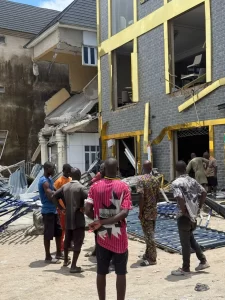The Ogun state government says it’s leveraging on the flood alert issues by the Nigeria Hydrological Agency and Nigeria Hydrological Services Agency (NIHSA) to mitigate the predicted flooding of some local government areas of the state.
Ogun state commissioner for environment, Mr. Ola Oresanya stated this at a news conference in Abeokuta to the state annual flood alert And prediction of rainfall for the year 2024.
Mr. Oresanya noted that sixteen, out of the twenty local government areas in the state is predicted to have the highest rainfall for the year include with over 1700mm while those with lowest rainfall are lmeko Afon (1541mm) Odeda (1658mm). Abeokuta North (1675mm) and Abeokuta –South (1699mm).
He explained further that due to the prediction, residents living on wetland areas of the State are advised to relocate to a safer ground or create a higher elevation within their residence while stressing that For Agricultural purposes, the length of the growing season for the coastal areas of the season ranges between 250 to 292 days, while that of inland areas is between 200 to 250 days.
The commissioner of environment maintained that Efforts are on by the state and the Federal Government to resolve the age long Isheri flood as it has commenced a comprehensive study of the drainage pattern in the area and the construction of 2,975.6m length of drainage channel and mini bridges/culverts, desilt and clear 56,150m length of river /stream courses and desilt 40,000m length of drainage channel across the three senatorial districts in the state.
The commissioner assured that the Ministry of Environment will continue to provide weekly update in English and local languages on expected weather condition and public enlightenment programmes to further inform and educate resident people in the state on the right things they need to do during raining seasons which include the habit of dumping wastes on drainage channels, clearing of their drainage channels of silts, not building on drainage channels, and placing of structures on public drainage channels.
|END|
Hezekiah Agbeoluwaye






